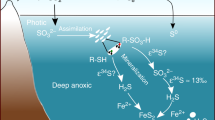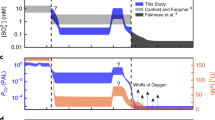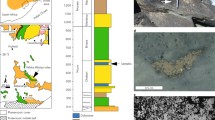Abstract
The biogeochemistry of sulfur and the mechanisms of sulfide/sulfate mineralization in Archean oceans have been thought by most geoscientists to have been much different from those in younger oceans. Archean oceans contained very little or no SO 2-4 , and sulfatereducing bacteria (SRB) were not active in the oceans. Fe-sulfides in the marine sediments formed directly from magmatic H2S, rather than by bacterial reduction of seawater sulfate. Bedded sulfate minerals in the marine sediments were formed by local oxidation of magmatic H2S by sulfide-oxidizing bacteria, rather than by evaporation of sulfate-rich seawater, and the massive Cu — Fe — Zn sulfide deposits associated with submarine volcanic rocks (volcanogenic massive sulfide deposits, VMSDs) were formed by magmatic H2S, rather than H2S-bearing fluids that developed from sulfate-bearing seawater through reactions with high temperature country rocks in the hydrothermal plumbing systems.
Critical examinations of the published and unpublished data on the sulfur isotopic characteristics (e.g. the skewness, range and mean values of the δ34S frequency curves, and the relationships between the rate of sulfate reduction and the kinetic isotopic effects) of marine sediments and VMSDs of various geologic ages and those of various laboratory systems, however, suggest that the biogeochemistry of sulfur and the mechanisms of sulfide/sulfate mineralization in the oceans have basically been the same since at least ~ 3.5 b.y. ago, except for some important differences in the environmental parameters for SRB. Archean oceans, as far back as ∼3.5 b.y. ago, were probably already sulfate-rich, with a sulfate concentration more than ∼1/3 of that in modern oceans (i.e. > 10 mM sulfate), and with a δ34S value of + 2%o (vs. + 20%o for the modern oceans). This model implies that the accumulation of free oxygen in the atmosphere predates 3.5 b.y. ago. SRB were probably more active in Archean oceans than in modern oceans, possibly because the ocean temperatures were about 30–40 °C higher, and more digestible foods were available for SRB. The higher ocean temperature and the higher availability of digestible foods for SRB may be related ultimately to the higher PCO2 (~10-2atm vs. 10-3.5atm of the present-day atmosphere) and the lower PO2 (~10-2.5atm vs. the present value of 10-0.7atm).
Access this chapter
Tax calculation will be finalised at checkout
Purchases are for personal use only
Preview
Unable to display preview. Download preview PDF.
Similar content being viewed by others
References
Aizenshtat Z, Lipiner G, Cohen Y (1984) Biogeochemistry of carbon and sulfur cycle in the microbial mats of the Solar Lake (Sinai). In: Cohen Y, Castenholz RW, Halvorson HO (eds) Microbial mats: stromatolites. Liss, New York, pp 281–312
Berner RA (1980) Early diagenesis -a theoretical approach. Univ Press, Princeton, 241 pp
Berner RA (1984) Sedimentary pyrite formation: a update. Geochim Cosmochim Acta 48: 605–615
Berner RA (1985) Sulfate reduction, organic matter decomposition and pyrite formation. Philos Trans R Soc London Ser A315:605–615
BluthGJ, Graham UM, Ohmoto H (1988) Sulfíde-sulfate chimneys on the East Pacific Rise, 11c and 13C N latitudes, pt2: sulfur isotopes. Can Mineral 26: 505–515
Cameron EM (1982) Sulfate and sulfate reduction in Early Precambrian oceans. Nature (London) 296:145–148
Chambers LA (1982) Sulfur isotope study of a modern intertidal environment, and the interpretation of ancient sulfìdes. Geochim Cosmochim Acta 46: 721–728
Chambers LA, Trudinger PA (1979) Microbiological fractionation of stable sulfur isotopes: a review and critique. Geomicrobiol J 1:249 -293
Chambers LA, Trudinger PA, Smith JW, Burns MS (1975) Fractionation of sulfur isotopes by continuous cultures of Desulfovibrio desulfuricans. Can J Microbiol 21: 1602–1607
Claypool GE, Holser WT, Kaplan IR, Sakai H, Zak I (1980) The age curves of sulfur and oxygen isotopes in marine sulfate and their mutual interpretations. Chem Geol 28:199–260
Cloud PE (1972) A working model of the primitive earth. Am J Sci 272:537–548
Franklin JM, Lydon JW, Sangster DF (1981) Volcanicassociated massive sulfìde deposits. Econ Geol 75th Anniv Vol, pp485–627
Fripp REP, Donelly TH, Lambert IB (1979) Sulphur isotope results for Archaean banded iron formation, Rhodesia. Spec Publ Geol Soc Afr 5:205–298
Fry B, Gest H, Hayes JM (1984) Isotope effects associated with anaerobic oxidation of sulfìde by the purple photosynthetic bacterium, Chromatium vinosum. FEMS Microbiol Lett 22:282–287
Fry B, CoxJ, Gest H, Hayes JM (1986) Discrimination between 34S and 32S during bacterial metabolism of inorganic sulfur compounds. J Bacterial 165: 328–330
Fry B, Ruf W, Gest H, Hayes JM (1988) Sulfur isotope effects associated with oxidation of sulfide by O2 in aqueous solution. Chem Geol 73:205–210
Goldhaber MB, Kaplan IR (1975) Controls and consequences of sulfate reduction rates in recent marine sediments. Soil Sci 119:42–55
Goodwin AM, Monster J, Thode HG (1976) Carbon and sulfur isotope abundances in Archean iron-formations and Early Precambrian life. Econ Geol 71:870–891
Grandstaff DE (1976) A kinetic study of the dissolution of uraninite. Econ Geol 71: 1493–1506
Harrison AG, Thode HG (1958) Mechanism of the bacterial reduction of sulphate from isotope fractionation studies. Trans Faraday Soc 54:84–92
Hattori K, Campbell FA, Krouse HR (1985) Sulphur isotope abundances in sedimentary rocks, relevance to the evolution of the Precambrian atmosphere. Geochem Int 22:97–114
Heinrichs TK, Reimer TO (1977) A sedimentary barite deposit from the Archean Fig Tree Group of the Barberton Mountain Land (South Africa). Econ Geol 72: 1426–1441
Holland HD (1984) The chemical evolution of the atmosphere and oceans. Univ Press, Princeton, 582 pp
Jørgensen B, Cohen Y (1977) Solar Lake (Sinai). 5. The sulfur cycle of the benthic cyanobacterial mats. Limnol Oceanogr 22:657–666
Kaplan IR. Rittenberg SC (1964) Microbiological fractionation of sulphur isotopes. J Gen Microbiol 34:195–212
Kasting JF (1987) Theoretical constraints on oxygen and carbon dioxide concentrations in the Precambrian atmosphere. J Geophys Res 84:3097–3107
Kasting JF, Ackerman TP (1986) Climatic consequences of very high carbon dioxide levels in the Earth’s early atmosphere. Science 234: 1383–1385
Kemp AL, Thode HG (1968) The mechanism of the bacterial reduction of sulphate and of sulphite from isotope fractionation studies. Geochim Cosmochim Acta 32:71–91
KusakabeM, Chiba H, Ohmoto H (1982) Stable isotopes and fluid inclusion study of anhydrite from the East Pacific Rise at 21CN. Geochem J 16:89–95
Lambert IB, Donnelly TH (1990) The paleoenvironmental significance of trends in sulphur isotope compositions in the Precambrian: a critical review. In: Herbert HK, Ho SE (eds) Stable isotopes and fluid processes in mineralisation. Univ West Aust Publ 23: 260–268
Lambert IB, Dunlop JSR, Groves DI (1978) Stable isotopic compositions of Early Archaean sulfate deposits of probable evaporitic and volcanogenic origins. Nature (London) 276:806–810
Lowe DR (1980) Archean sedimentation. Annu Rev Earth Planet Sci 8:145–167
Lowe DR, Knauth PR (1977) Sedimentology of the Onver-wacht Group (3.4 billion years), Transvaal, South Africa, and its bearing on the characteristics and evolution of the early earth. J Geol 85:699–723
Monster J, Appel PWU, Thode HG, Schidlowski M, Carmichael CM, Bridgewater D (1979) Sulfur isotope studies in Early Archaean sediments from Isua, West Greenland: implications for the antiquaty of bacterial sulfate reduction. Geochim Cosmochim Acta 43:405–413
Ohmoto H (1986) Stable isotope geochemistry of ore deposits. In: Valley JE, Taylor HP Jr, O’Neil JR (eds) Stable isotopes in high temperature geological processes. Rev Mineral 16:491–560
Ohmoto H (in preparation) Formation of volcanogenic massive sulfìde deposits
Ohmoto H, Felder RP (1987) Bacterial activity in the warmer, sulphate-bearing, Archaean oceans. Nature (London) 328:244–246
Ohmoto H, Lasaga AC (1982) Kinetics of reactions between aqueous sulfates and sulfìdes in hydrothermal systems. Geochim Cosmochim Acta 46: 1727–1745
Ohmoto H, Rye RO (1979) Isotopes of sulfur and carbon. In: Barnes HL (ed) Geochemistry of hydrothermal ore deposits, 2nd edn. John Wiley & Sons, New York, pp 509– 567
Ohmoto H, Skinner BJ (eds) (1983) The Kuroko and related volcanogenic related massive sulfide deposits. Econ Geol Monogr 5, 604pp
Ohmoto H, Mizukami M, Drummond SE, Eldridge CS, Pisutha-Arnond V, Lenagh TC (1983) Chemical processes of Kuroko formation. Econ Geol Monogr 5: 570– 604
Ohmoto H. Kaiser CJ. Geer KA (1990) Systematics of sulphur isotopes in recent marine sediments and ancient sediment-hosted basemetal deposits. In: Herbert HK,Ho SE (eds) Stable isotopes and fluid processes in mineralisation. Univ West Aust Publ 23: 70–120
Ohmoto H, Kurai H, Hayashi K, Lowe DR (in preparation) Sulfur isotope study of barite beds in the Fig Tree Formation, Barberton district, South Africa
Owen T, Cess RD, Ramanathan V (1979) Enhanced CO2 greenhouse to compensate for reduced solar luminosity on early Earth. Nature (London) 277:640–642
Perry EC Jr, Monster J, Reimer T (1970) Sulfur isotopes in Swaziland system barites and the evolution of the Earth’s atmosphere. Science 171: 1015–1016
Postgate JR (1984) The sulfate-reducing bacteria, 2nd edn Univ Press, Cambridge, 208 pp
Reimer TO (1980) Archean sedimentary baryte deposits of the Swaziland Supergroup (Barberton Mountain Land, South Africa). Precambrian Res 12: 393–410
Reimer TO (1982) Sulfur isotopes and the derivation of detrital barytes of the Archean Fig Tree Group (South Africa). In: Sidorenko AV (ed) Sedimentary geology of highly metamorphosed Precambrian complexes. Nauka, Moscow, pp63–74
Schwarcz HP, Burnie SW (1973) Influence of sedimentary environments on sulfur isotope ratios in clastic rocks: a review. Mineral Depos 8:264–277
Schidlowski M, Hayes JM, Kaplan IR (1983) Isotopic inferences of ancient biochemistries: carbon, sulfur, hydrogen, and nitrogen. In: Schopf JW (ed) Earth’s earliest biosphere. Univ Press, Princeton, pp149–186
Seccombe PK (1977) Sulphur isotope and trace metal composition of straitiform sulphides as an ore guide in the Canadian Shield. J Geochem Explor 8: 117–137
Skyring GW (1987) Sulfate reduction in coastal ecosystems. Geomicrobiol J 5:295–374
Skyring GW, Donnelly TH (1982) Precambrian sulfur isotopes and a possible role for sulfide in the evolution of biological sulfate reduction. Precambrian Res 17:41–61
Thode HG, Goodwin AM (1983) Further sulfur and carbon isotope studies of Late Archean iron-formations of the Canadian Shild and the rise of sulfate reducing bacteria. In: Nagy B, Weber R, Guerrero JC, Schidlowski M (eds) Developments and interactions of the Precambrian atmosphere, lithosphere and biosphere. Elsevier, Amsterdam, pp229–248
Thode HG, Monster J (1965) Sulfur isotope geochemistry of petroleum, evaporites, and ancient seas. Am Assoc Petrol Geol Mem 4:367–377
Vaynshteyn MB, Tokarev VG, Shakola VA, Lein AYu, Ivanov MV (1986) The geochemical activity of sulfatereducing bacteria in sediments in the western part of the Black Sea. Geochem Int 23: 110–112
Vinogradov V, Reimer TO, Leites AM, Smelov SB (1977) The oldest sulfates in the Archean formations of the South African and the Aldan Shields, and the evolution of the Earth’s oxygen atmosphere. Lithol Mineral Resourc 11:407–420
Walker JCG, Brimblecombe P (1985) Iron and sulfur in the pre-biologic ocean. Precambrian Res 28: 205–222
Walker JCG, Klein C, Schidlowski M, Stevenson DJ, Walter MR (1983) Environmental evolution of the Archean-Early Proterozoic earth. In: Schopf JW (ed) Earth’s earliest biosphere. Univ Press, Princeton, pp 260–290
Westrich JT, Berner RA (1988) The effect of temperature on rates of sulfate reduction in marine sediments. Geomicrobiology J 6:99–117
Author information
Authors and Affiliations
Editor information
Editors and Affiliations
Rights and permissions
Copyright information
© 1992 Springer-Verlag Berlin Heidelberg
About this chapter
Cite this chapter
Ohmoto, H. (1992). Biogeochemistry of Sulfur and the Mechanisms of Sulfide-Sulfate Mineralization in Archean Oceans. In: Schidlowski, M., Golubic, S., Kimberley, M.M., McKirdy, D.M., Trudinger, P.A. (eds) Early Organic Evolution. Springer, Berlin, Heidelberg. https://doi.org/10.1007/978-3-642-76884-2_29
Download citation
DOI: https://doi.org/10.1007/978-3-642-76884-2_29
Publisher Name: Springer, Berlin, Heidelberg
Print ISBN: 978-3-642-76886-6
Online ISBN: 978-3-642-76884-2
eBook Packages: Springer Book Archive




